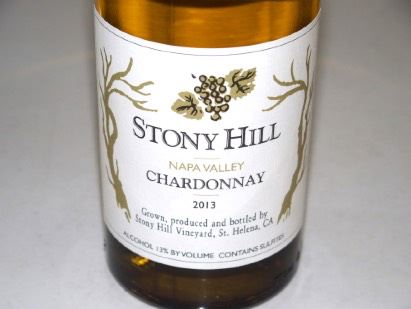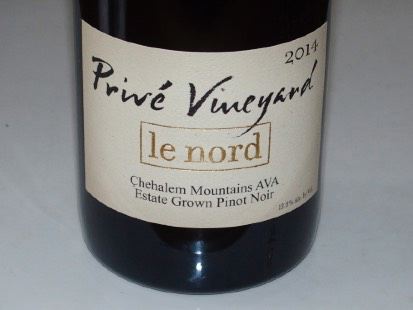Pinot Briefs
—Newsletter 11.30
New West Sonoma Coast AVA Approval on Horizon Elin McCoy recently wrote an article
about the West Sonoma Coast, https://www.bloomberg.com/news/articles/2018-08-31/california-s-edgiestriskiest-wine-region-is-about-to-get-a-new-name, a 51-mile-long piece of land also known as the “true Sonoma
Coast,” and the “far Sonoma Coast.” This region is home to some of California’s best Pinot Noir vineyards.
Winegrower members of the West Sonoma Coast Vintners in this region have been trying for several years to
get approval for the “West Sonoma Coast” AVA to distinguish it from the very large “Sonoma Coast” AVA, and
they expect official acceptance by early 2019. The new West Sonoma Coast AVA would encompass the Fort
Ross-Seaview AVA and Green Valley AVA as well as the Annapolis, Freestone, Occidental and Sebastopol Hills
regions.
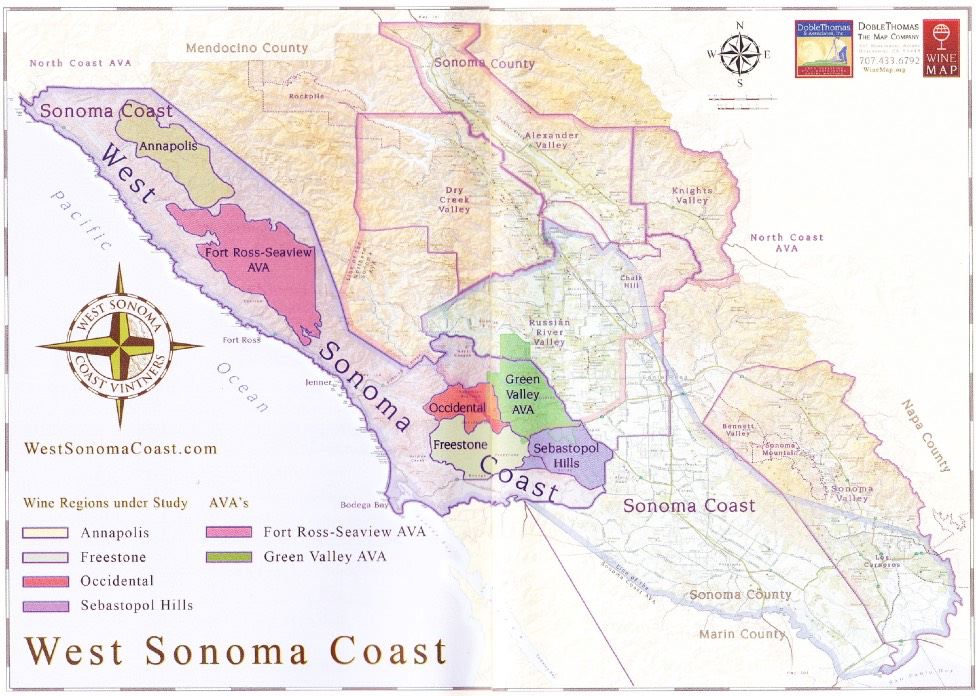
Stony Hill Vineyard Sold The iconic Stony Hill Vineyard has been bought by the Hall family, owners
of Long Meadow Ranch. Stony Hill Vineyard has been owned by the McCrea family over three generations and
is famous for its Chardonnay, Riesling and Gewürztraminer.
New Book: Flawless: Understanding Faults in Wine Author Jamie Goode is one of our best
wine experts and writers and I have collected all of his books. This book is said to be written more for the wine
trade, but wine connoisseurs will undoubtedly find it educational. Besides covering all the main faults, some
taints such as smoke taint and cork taint are also included.

The Donum Estate Building New Winery A new roughly $6 million winemaking facility on the
Donum property is expected to be finished by the end of 2018. The Donum wines are produced at Santa
Rosa’s Punchdown custom crush facility, but it is expected that the winery will handle all production in 2019.
A new tasting room opened at the estate in late 2017 and guests can also walk through the vineyards featuring
sculpture displays. The Donum Estate currently has 130 acres in Carneros, 20 acres in the Russian River
Valley, and 9 acres in Anderson Valley. Most recently, a 100-acre site was acquired in the Sonoma Coast and
plans are afoot to plant 20 acres, called Platt Ranch. Most Donum Pinot Noir and Chardonnay production is
sold directly to consumers. Visit www.thedonumestate.com.
Sonoma & Oregon lead DTC Sales Change in First Half of 2018 According to Wines &
Vines, https://www.winesandvines.com/news/article/202959/Sonoma-DtC-Wine-Shipments-Surpass-Napa,
Sonoma wineries shipped 877, 795 cases DTC in the first six months of 2018 which is a 29% increase
compared to the first half of 2017. Oregon saw case volumes shipped DtC rise 26% in the first half of 2018.
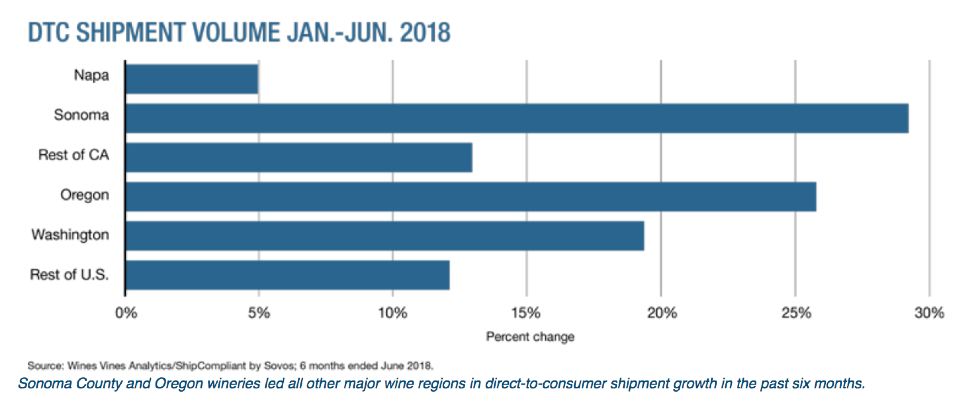
Louis M. Martini Restoring Historic Winery Louis M. Martini Winery, one of Napa Valley’s
founding wineries at the end of Prohibition, is restoring their historic 1933 winery and planning on a scheduled
opening in March 2019. Architect Howard Backen is seeking to preserve the building’s unique structural
elements while creating an atrium to draw guests into the open floor plan. The building will have 30-foot-high
glass alls with views into the barrel cellar, a demonstration dining room, an underground cellar with private wine
libraries and a range of immersive Cabernet Sauvignon experiences. The adjacent Martini Park will feature a
sycamore grove with tables and private cabanas for al fresco wine service.
Update on Privé Vineyard The property and winery are still for sale but owner Tina Hammond tells me
they have not found the right buyer yet. In the meantime, the winery is happy to welcome new members to their
wine family. Last week, I opened a 2016 Privé Vineyard le nord Chehalem Mountains Pinot Noir and it was
glorious. Visit or join the mailing list at www.privevineyard.com.
Appointment-Only versus Public Wineries by Region
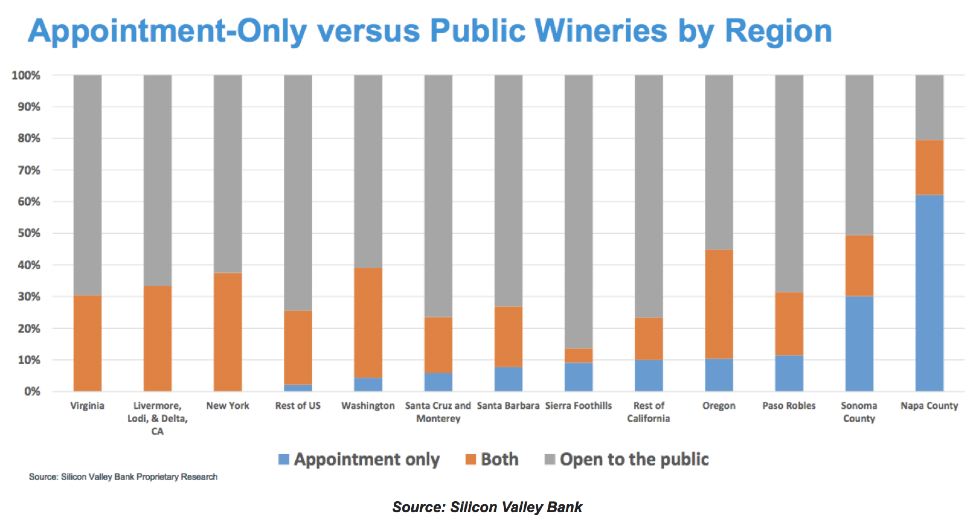
Book: Wine Grape Varieties in California I came across this excellent book recently. It was
published in 2003 and authored by ten scholars either at UC Davis or part of the University of California
Cooperative Extension Program. It is a reference book that was the first comprehensive wine grape variety
publication covering all wine growing regions of California. Organized by grape variety, each section includes a
discussion of the wine grapevine structure and terms that you often hear at wineries but never understood such
as peticle, node, peduncle, rachis and pedicel. Also included are ripening periods, regional ripening dates,
proper rootstock selection and appropriate trellis systems. There are valuable illustrations as well as
photographs of clusters on the vine and leaves to show morphology. Minor wine grape varieties are also
included in a summary format. A few interesting factoids about Chardonnay in the book: In 1960, there were an
estimated 150 acres planted and by 2000, 103,491 acres planted, becoming the most widely planted wine
grape variety in California. Besides the well-known Wente and Dijon clones, the Chardonnay musqué
selections include Rued, See’s, Spring Mountain and Sterling. There are nearly 100 clones and sub-clones
available. Since it is one of the first varieties to begin growth in the spring, it is susceptible to frost injury.
Chardonnay is also susceptible to powdery mildew and Pierce’s disease. A few interesting factoids about Pinot
Noir in the book: It is the oldest cultivated variety of genus Vitus and was described by Roman authors in the
1st century. Early bud break puts it at risk for spring frost. There are more clones of Pinot Noir than any other
wine grape variety and most are from France. In 2003, there were 50 selections commercially available as
FPS-registered selections but this has certainly increased since then. Pinot Noir is susceptible to bunch rot,
Pierce’s disease and thrips. $25 on Amazon.
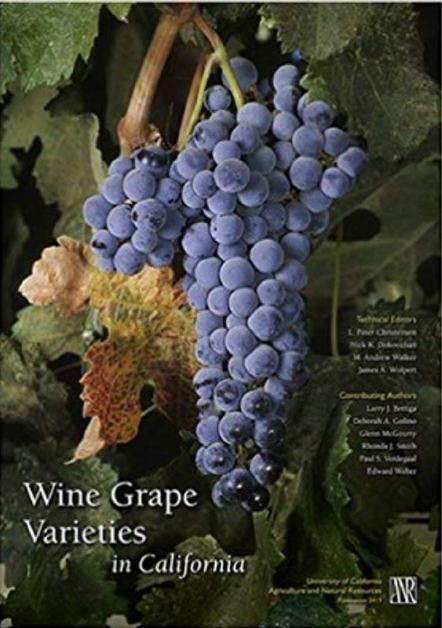
Proposition 65 Warning The State of California lists substances known to cause cancer, birth defects
or reproductive harm in Proposition 65, also called the Safe Drinking Water and Toxic Enforcement Act. Alcohol
is one of the substances. The Proposition was enacted in 1986 and led to back label warnings on wine bottles.
On August 30, 2018, new more detailed and complex regulations took effect and businesses must be vigilant to
remain in compliance. California DTC shipments must include Prop 65 warnings, whether the wine is coming
from inside or outside the state. If the wine container or wine shipment containers contain BPA (tin in bottle
caps for example), then an alcohol warning and a Prop 65 warning must be included on the outside or inside
the box where the consumer can easily see and read the warning statements:
WARNING: This product can expose you to chemicals including Bisphenol A
(BPA), which are known to the State of California to cause birth defects or other
reproductive harm.
WARNING: Drinking distilled spirits, beer, coolers, wine and other alcoholic
beverages may increase cancer risk, and, during pregnancy, can cause birth
defects.
The warnings should also be posted in the winery’s tasting room and on the website.
Read more at www.compli-beverage.com.
Aerators of Little Value for Domestic Pinot Noir I have always been skeptical of the value of
aerators for most domestic Pinot Noir wines. Nearly all domestic Pinot Noir produced today is ready to drink
upon release. The active swirling of wine in a glass suitable for Pinot Noir accomplishes what an aerator does. I
was at a winery a while back and they used a Vinturi wine aerator ($25) and it seemed to show off the Pinot
Noir better than when poured directly from the bottle. I bought one to test at home during my tastings but did
not find that it made an appreciable difference compared to swirling the wine in a glass. I receive marketing
material about all sorts of aerators, some costing triple digits, but I do not believe they are of significant value
for domestic Pinot Noir. If you really want to aerate a Pinot Noir, I would decant it.




